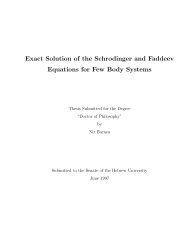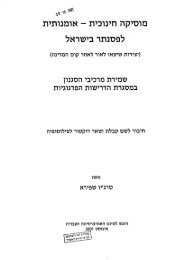Revealing the Mechanism of HSP104 Transcription Initiation in the ...
Revealing the Mechanism of HSP104 Transcription Initiation in the ...
Revealing the Mechanism of HSP104 Transcription Initiation in the ...
You also want an ePaper? Increase the reach of your titles
YUMPU automatically turns print PDFs into web optimized ePapers that Google loves.
promoter. III) The identification <strong>of</strong> components <strong>of</strong> <strong>the</strong> basal transcription mach<strong>in</strong>ery<br />
<strong>in</strong>volved specifically <strong>in</strong> transcriptionally activat<strong>in</strong>g <strong>HSP104</strong>.<br />
The results obta<strong>in</strong>ed allow us to draw a detailed work<strong>in</strong>g model for <strong>the</strong><br />
molecular events occurr<strong>in</strong>g on <strong>the</strong> <strong>HSP104</strong> promoter <strong>in</strong> response to heat shock (see<br />
details <strong>in</strong> <strong>the</strong> last section <strong>of</strong> <strong>the</strong> Discussion). The first aspect <strong>of</strong> our promoter analysis<br />
dealt with, as mentioned above, analyz<strong>in</strong>g <strong>the</strong> promoter through 5’deletion [most<br />
aspects <strong>of</strong> promoter analysis are thoroughly described <strong>in</strong> (47)]. We sought at this<br />
stage <strong>of</strong> our study, to identify sequences which are required for <strong>the</strong> high basal activity<br />
<strong>of</strong> -334LacZ reporter. We found <strong>the</strong> putative s<strong>in</strong>gle HSE site between (-304 and -300)<br />
to have an important role <strong>in</strong> this promoter activity. In fact, our f<strong>in</strong>e-tuned mapp<strong>in</strong>g<br />
effort did not po<strong>in</strong>t at an additional particular sequence with<strong>in</strong> <strong>the</strong> 34bp as responsible<br />
for <strong>the</strong> activity. We fur<strong>the</strong>r conclude that <strong>the</strong> 34bp (particularly <strong>the</strong> HSE between -<br />
304 and -300) may possibly be required to <strong>in</strong>teract with <strong>the</strong> specific basal<br />
transcription mach<strong>in</strong>ery <strong>of</strong> <strong>HSP104</strong> (this conclusion is also based on <strong>the</strong> results with<br />
<strong>the</strong> heterologous promoter, Fig. 7). We <strong>the</strong>refore attempted to analyze <strong>the</strong> <strong>in</strong>teraction<br />
between <strong>the</strong> 34bp with <strong>the</strong> basal transcription mach<strong>in</strong>ery by delet<strong>in</strong>g an <strong>in</strong>ternal<br />
fragment <strong>of</strong> 78bp, <strong>the</strong>reby br<strong>in</strong>g<strong>in</strong>g <strong>the</strong> 34bp close to <strong>the</strong> m<strong>in</strong>imal promoter. The<br />
various ∆78 constructs manifested low basal activity, suggest<strong>in</strong>g that perhaps <strong>the</strong><br />
spatial organization between <strong>the</strong> 34bp and <strong>the</strong> basal transcription mach<strong>in</strong>ery is critical<br />
for <strong>the</strong> basal activity <strong>of</strong> <strong>the</strong> <strong>HSP104</strong> promoter. It could also be that STREs, removed<br />
with <strong>the</strong> <strong>in</strong>ternal 78bp, are required for basal activity. The ∆78 constructs provided<br />
important <strong>in</strong>formation about <strong>the</strong> flexibility and modularity <strong>of</strong> <strong>the</strong> promoter (Fig. 8).<br />
Normally, <strong>the</strong>re is complete cooperation between STRE/Msn2/4 and HSE/Hsf1<br />
systems for optimal promoter activity. Yet, under specific conditions, such as <strong>in</strong><br />
msn2∆msn4∆ cells, <strong>HSP104</strong> is solely activated by <strong>the</strong> HSE/Hsf1 system. Conversely,<br />
<strong>in</strong> ras2∆ cells, <strong>the</strong> HSE/Hsf1 system is not required for <strong>the</strong> activation <strong>of</strong> <strong>HSP104</strong><br />
promoter activity. High activity <strong>of</strong> <strong>HSP104</strong> <strong>in</strong> this stra<strong>in</strong> is due to <strong>the</strong> hypo<strong>the</strong>sized<br />
constitutive b<strong>in</strong>d<strong>in</strong>g <strong>of</strong> Msn2/4 to <strong>the</strong> STREs present on <strong>the</strong> promoter. This<br />
flexibility and back-up capabilities <strong>of</strong> <strong>the</strong> HSE/Hsf1 and STRE/Msn2/4 systems are<br />
now fur<strong>the</strong>r expanded and <strong>in</strong>clude <strong>the</strong> upstream 34bp that become Ras2 responsive <strong>in</strong><br />
cells lack<strong>in</strong>g Msn2/4 and <strong>the</strong> <strong>in</strong>ternal 78bp, that under various conditions, affect not<br />
only <strong>in</strong>duced, but also basal promoter activity. Namely, promoter flexibility is much<br />
stronger than we previously suggested and many cis and trans-elements are back<strong>in</strong>g<br />
up each o<strong>the</strong>r to allow promoter activity under various circumstances. Measur<strong>in</strong>g<br />
48
















